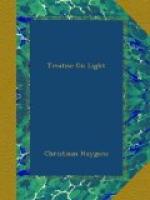Then the wave TG, after having passed through the glass, must form the wave QD; and for this I observe that the time taken by the light along GD in the glass must be equal to that taken along the three, TA, AB, and BQ, of which AB alone is within the glass. Or rather, having taken AS equal to 2/3 of AT, I observe that 3/2 of GD ought to be equal to 3/2 of SB, plus BQ; and, deducting both of them from FD or FQ, that FD less 3/2 of GD ought to be equal to FB less 3/2 of SB. And this last difference is a given length: and all that is required is to draw the straight line FD from the given point F to meet VG so that it may be thus. Which is a problem quite similar to that which served for the first of these constructions, where FD plus 3/2 of GD had to be equal to a given length.
In the demonstration it is to be observed that, since the arc BC falls within the glass, there must be conceived an arc RX, concentric with it and on the other side of QD. Then after it shall have been shown that the piece G of the wave GT arrives at D at the same time that the piece T arrives at Q, which is easily deduced from the construction, it will be evident as a consequence that the partial wave generated at the point D will touch the arc RX at the moment when the piece Q shall have come to R, and that thus this arc will at the same moment be the termination of the movement that comes from the wave TG; whence all the rest may be concluded.
Having shown the method of finding these curved lines which serve for the perfect concurrence of the rays, there remains to be explained a notable thing touching the uncoordinated refraction of spherical, plane, and other surfaces: an effect which if ignored might cause some doubt concerning what we have several times said, that rays of light are straight lines which intersect at right angles the waves which travel along them.
[Illustration]
For in the case of rays which, for example, fall parallel upon a spherical surface AFE, intersecting one another, after refraction, at different points, as this figure represents; what can the waves of light be, in this transparent body, which are cut at right angles by the converging rays? For they can not be spherical. And what will these waves become after the said rays begin to intersect one another? It will be seen in the solution of this difficulty that something very remarkable comes to pass herein, and that the waves do not cease to persist though they do not continue entire, as when they cross the glasses designed according to the construction we have seen.




